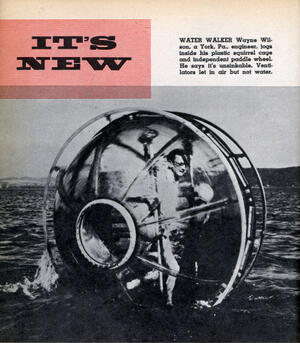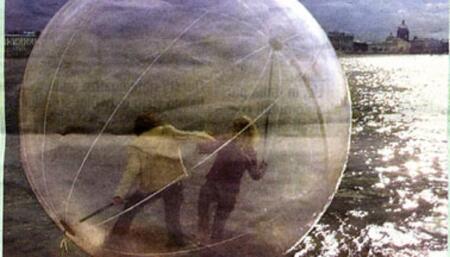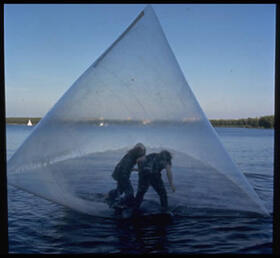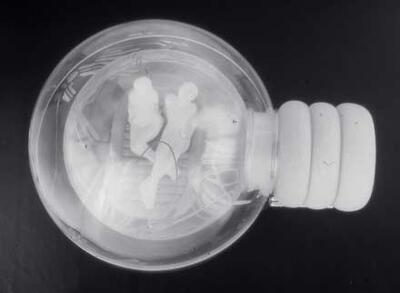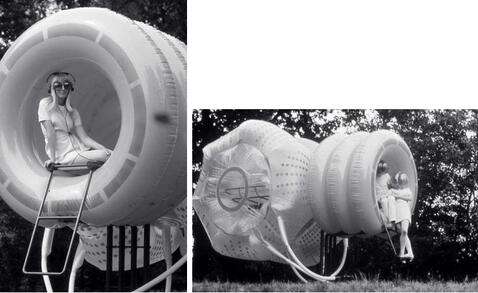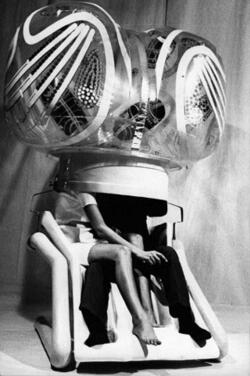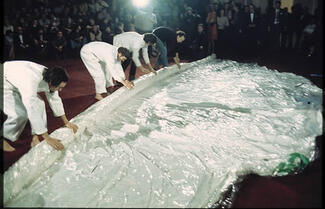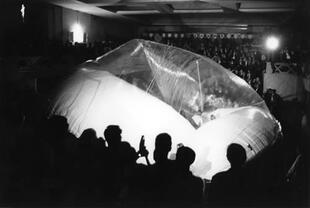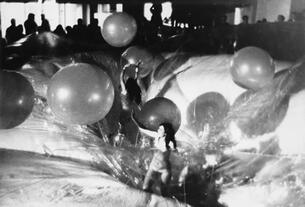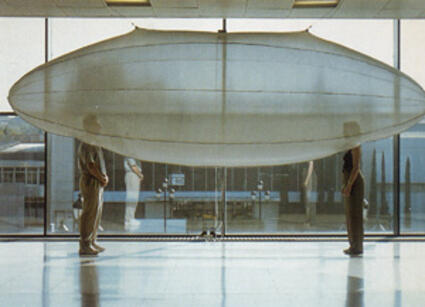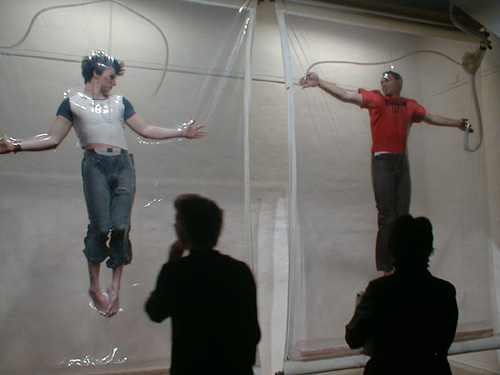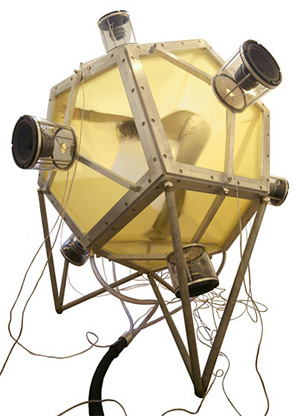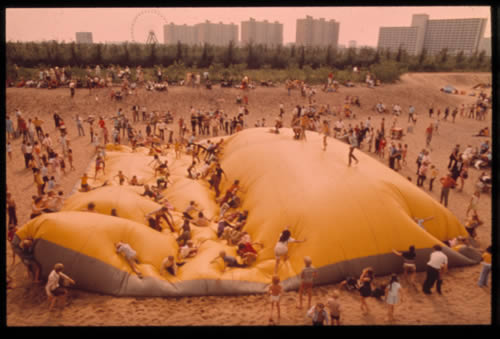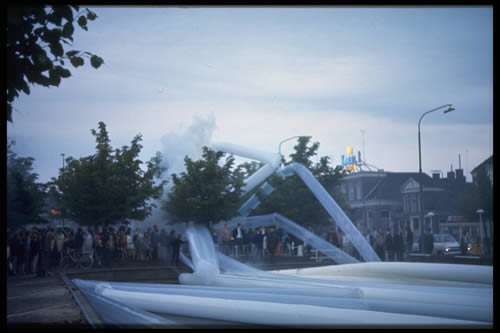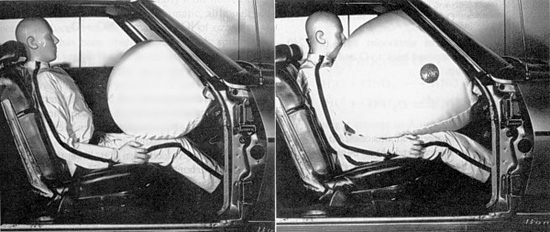This is an old revision of the document!
Experience Inflatables
Experience Inflatables - are inflatables that relate to the human body/mind where beforehand one doesn't know exactly what will happen when they start to mingle
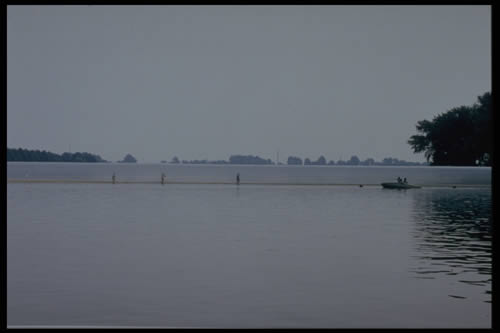
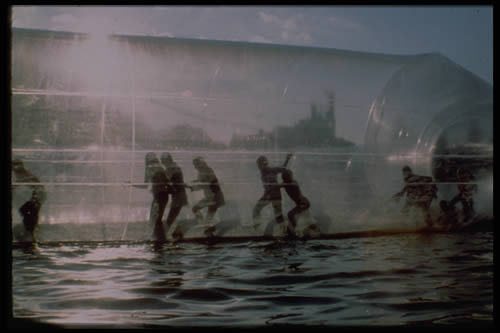
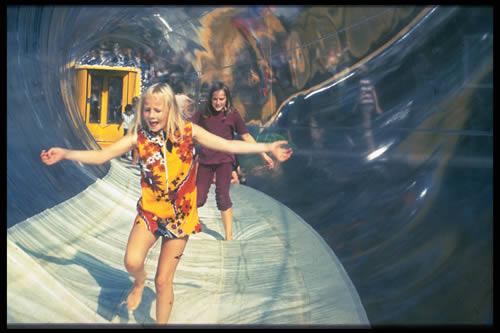
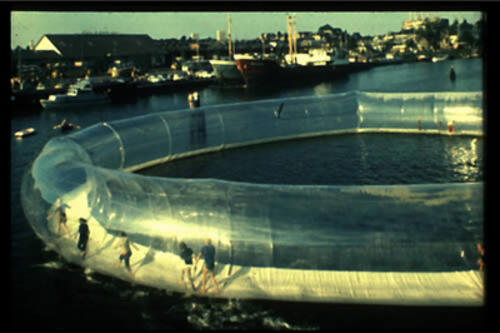
Waterwalk Tube: Theo Botschuiver & Jeffrey Shaw 1970
An inflatable tube made from transparent plastic, 250 metres long and 3 metres in diameter, was placed over the Masch lake connecting its opposite banks. This air-filled floating bridge had airlock revolving doors at each end, and its pliable floor was in direct contact with the water surface. Visitors were able to enter this almost immaterial structure and cross from one side of the lake to the other as if walking on water. In Groningen the tube was placed in a U-shape in the harbor in the front of the Central station (where the new Groningen Museum is now located).
source: http://www.jeffrey-shaw.net
Old and a new versions of the waterball
old one: Wayne Wilson, http://blog.modernmechanix.com
new one: Theo Botschuiver
\
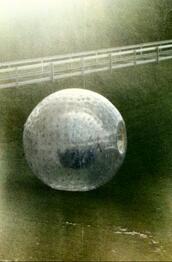
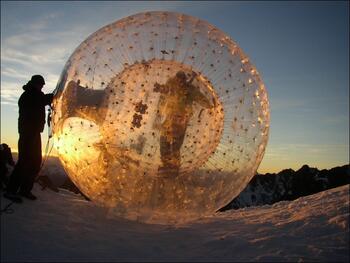
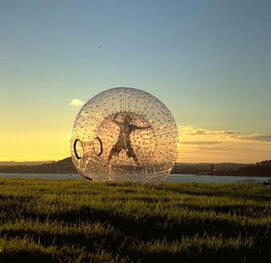
Zorb: Zorbs are rolling all over the world: the zorb-speed record rolling downhill is 65km/hours
Yellow Heart: Haus-Rucker-Co, Viena, 1968
The idea that a concentrated experience of space could offer a direct approach to changes in consciousness led to the construction of a pneumatic space capsule, called the 'Yellow Heart'. Through a lock made of three air rings one arrived at a transparent plastic mattress. Offering just enough space for two people it projected into the centre of a spherical space that was made up of soft, air-filled chambers. Lying there one could perceive that the air-filled “pillows”, whose swelling sides almost touched one, slowly withdrew, that is to say the surrounding space appeared to expand, finally forming a translucent sphere and then, in a reverse motion, flowed out again. Large dots arranged in a grid on the outer and inner surfaces of the air-shells changed in rhythmic waves from milky patches to a clear pattern. The space pulsated at extended intervals.
Yellow hart is an inflatable device fusing architecture with the mechanics of the body (breathing) concerned with the possibility of achieving higher state of consciousness by means of concentrated spatial experience.
source: http://www.the-artists.org/Images/haus-rucker-co
Mind Expander: Haus-Rucker-Co, Vienna 1967
The seat shell fixes two persons in a certain position. The lower seat allows one person to sit with their legs slightly open. The thigh of their right leg rests against a step forming the transition to a second seat area that is higher by the thickness of a thigh.
A helmet-like balloon that is connected with the seat can be tilted over the heads of the two people seated. Their heads thus are enclosed a narrow cylindrical space that is covered by a glass-clear plastic dome above which a transparent balloon hovers. A series of lines and stamped-out shapes made of reflective foil are placed on both the dome and the surface of the balloon in such a way that, depending on whether you concentrate on the level closer or further away from you, the elements constantly overlay each other to form new patterns.
The machines in Mind expanding program blended futuristic forms, colors, and sounds in an attempt to induce a trance-like state.
source: http://www.the-artists.org/Images/haus-rucker-co
Movie Movie - 1967
Theo Botschuijver, Sean Wellesley-Miller, Tjebbe van Tijen & jeffrey Shaw While the inflatable steucture was being gradually inflated, film, slides and liquid-light show effects were projected onto its surface. Its fully inflated shape was a 7m diameter and 10m high cone with an outer transparent membrane and an inner white surface. The projected imagery first impinged lightly on the outer envelope and then appeared on the semi-inflated inner surface; in the intermediate space various material actions were performed.
The intention of this work was to transmute the conventional flat cinema projection screen into a three dimensional kinetic and architectonic space of visualisation. The multiple projection surfaces allowed the images to materialise in many layers, and of the audience (many of whom spontaneously took off all their clothes) became part of the cinematic spectacle. In this way the immersive space of cinematic fiction included the literal and interactive immersion of the viewers who modulating the changing shapes of the pneumatic architecture which in turn modulated the shifting deformations of the projected imagery.With speakers placed both outside and inside the structure, its acoustic environment was also modulated in this way.
source: http://www.jeffrey-shaw.net
La Parole: Pablo Reinoso, 1998 Spectators can introduced their heads into a suspend inflated volume. Inside speech is autonomous, separated from the body. It separates the viewers head from their bodies and focuses their attention on their mind.
Shrink: Lawrence Malstaf, 1996
“People could in a rather private situation go inside, I would explain and guide them, have a conversation afterwards. This was very personal and interesting to see that what you feel inside is opposite of what you see from outside. Someone called it the big hug. If you're able to let go of the first fear it becomes very relaxing and comfortable. You feel protected inside, a feeling of weightlessness and pressure. People relate it to the womb and rebirth. So maybe the experience itself would have been more appropriate than theimage of packed meat.”
Vacuum Packing: Makoto Ishiwata, 2006
Vacuum packs its inhabitant from all sides in rubber and a rhythmic soundscape. Ishiwata intentions were to create a space for self-reflection and meditation. The heartbeat also encouraging the sense of internal space “I can feel like an individual in the midst of humanity, through the image of something internal such as a cell, an atom, or a fetus. Keeping in mind the insignificance of humanity, as I shrink ever smaller, it may be possible to confirm my existence in the universe on an electronic level. Or this work may simply serve as a space to meditate. The heartbeat is the very first rhythm humans feel. I believe all music has the heartbeat as its source. The moment that human beings connect to the heartbeat that flows within us, the music that we hear starts to sound right.”
Airground Mattress: 1968 Jeffrey Shaw & Theo Boschuiver,[aswell the inventor of the “jump cushion”]
source: http://www.jeffrey-shaw.net
Waterquake: Theo Botschuiver & Jeffrey Shaw, 1970
In Waterquake long lengths of tubing were dropped into a canal and then slowly inflated with air and smoke. The tubing emerged from the water, filling the canal and then spilling over into the surrounding streets. The spectators pulled and knotted these tubes into various forms - when they broke holes in the plastic skin the smoke inside was released.
source: http://www.jeffrey-shaw.net
Air Bag: Cocky Eek, Paard-Den Haag (NL), 2000 Where the audience could participate to be launched like a catapult, flying through the space; landing in the airbag, bouncing up again… [bag attached to the body, air, bungiecord]
more inflatable image sections: Powered by Wind - Parasite Inflatables - Soap Experiences - When Nature Inflates - Environmental Blendings - Hardened Bubbles - Inflatable Spaces - Inflatable Sound - Interactive Inflatables - Inflatable Wearables - The Non Categorized Inflatables - Lighter than Air - NASA Inflatables
or go back: Cocky Eek
– Cocky Eek - 30 Jan 2007
